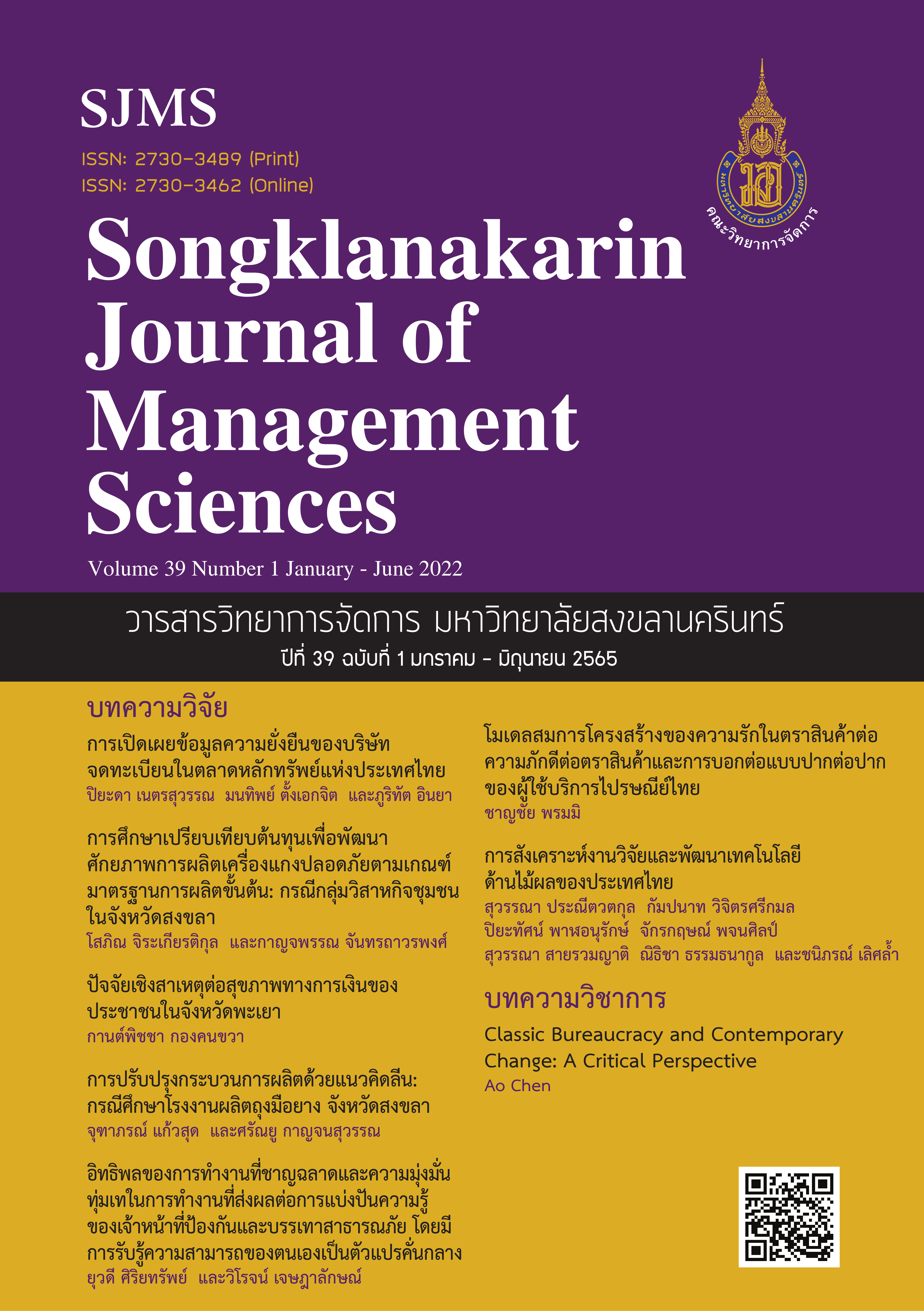A Comparative Study of Production Costs for Enhancing Safe Curry Paste Production Based on primary GMP Standard: A Case of Community Enterprises in Songkhla Province
Main Article Content
Abstract
Southern Thailand curry paste is an identity food ingredient. Nowadays, its production has been scaled up to generate a supplemental income for local households. It is therefore necessary to have a production process that protects health of consumers. The objectives of this study were to determine the cost for safe curry paste production of 40 curry paste producing community enterprises in Songkla province by the concept of cost of manufactured product. Data collection was carried out by assessing and scoring the operation at production sites based on the primary Good Manufacturing Practice (pGMP) criteria associated with interviewing the chairman and principal committees of the community enterprises. Curry paste producing groups were classified into three groups according to their level of readiness to be complied with the pGMP standard ranging from high, medium, and low. Data analysis showed that the major part of the production cost came from raw materials expense. We found that the high level group had the lowest production per unit cost due to its ability to purchase and stock raw materials in advance so as to avoid prices fluctuation and to secure the continuation of the production supply. Budget was also systematically allocated in the case of the high level group. This study reveals the limitations and potential for enhancing capacity development of each curry paste community enterprise to meet the primary standards. Noticing the cost of production of community enterprises with different basic standards leads to good management, efficient planning and cost control. In addition, creating a network of shared learning between governmental sector and community enterprises in managing production costs and product standards brings to generate income for households in the community.
Article Details

This work is licensed under a Creative Commons Attribution-NonCommercial-NoDerivatives 4.0 International License.
All published articles are SJMS’s copyright. The editorial board allows all published articles to be copied, excerpted, or disseminated with academic citation.
References
Auejirapongpan, S. (2008). Cost Accounting. McGraw-Hill. Bangkok.
Boonmee, T., Nilwan, D., Chum-Un, M., Boonmee, J., Soukaew, R., Tharapitakwong, S., & Nochai, B. (2014). The Research and Development for Community Enterprises in a case of Sansaitonkok village, Tambon Fa-Ham, Muang District, Chiang Mai Province. Journal of Community Development and Life Quality, 2(1), 63-72.
Changwatchai, P. (2014). The Potential Development of A Food Processing Community Enterprise in Nakhon Pathom. Proceedings of 52nd Kasetsart University Annual Conference: Education, Economics and Business Administration, Humanities and Social Sciences. ISBN: 978-616-278-143-8.
Cheamngoan, S., Chumjai, P., & Sriboonruang, P. (2017). Factors Affecting the Success of Sri Chum Saeng Wine Community Enterprise, Tha Mai Ruak Sub-district, Tha Yang District, Phetchaburi Province. King Mongkut’s Agricultural Journal, 35(3), 127-136.
Deeprasertwong, K. (n.d.). Food and Drug Administration of Thailand. GMP กฎหมาย updates. Retrieved March 11, 2019, from http://food.fda.moph.go.th/data/document/2554/GMP4-2_LAW_Information.pdf
Department of Agricultural Extension. (n.d.). Secretariat of the Community Enterprise Promotion Committees. Capability Evaluation Manual for Community Enterprises. Retrieved March 11, 2019, from http://www.sceb.doae.go.th/DataAdvertise/คู่มือประเมินศักยภาพวิสาหกิจชุมชน.pdf
FAO. (2014). Guidance on Hygiene and Safety in the Food RetailSector. RAP PUBLICATION 2014/16. Bangkok. E-ISBN 978-92- 5-108507-3 (PDF). Retrieved March 11, 2019, from http://www.fao.org/3/a-i3986e.pdf
Jensantikul, N. (2019). The Development of Community Enterprise in Lower Central Provinces Region 1 to Enhance its Competitiveness in the ASEAN Community. Political Science and Public Administration Journal, 10(1), 95-120.
Khunthongjan, S. (2016). Economic and Social Cost and Investment Return of Huarue-Chili Agriculturist in Ban Huarue. Silpakorn University Journal (Thai), 36(3), 169-185.
Kittipolpakdee, T., Chantarasiri, W., & Pooripanpinyo, A. (2019). Quality Evaluation of Product from Curry Paste Community Enterprise in Songkla Province (Thai). Walailak Procedia, 2019(3): ST.60
Ministry of Public Health. Food and Drug Administration of Thailand. (n.d.). Guidance for Primary GMP. Retrieved March 11, 2019, from http://www.fda.moph.go.th/sites/logistics/Shared%20Documents/Other/KSKPS/PrimaryGMPfinal.pdf
Prommaroeng, S. (2018). The Elevation Approach of OTOP’s Foods Which Produced in Mae Ban Rim Rong Community Enterprise of Makeujae Sub-district, Muang District, Lamphun Province. Journal of Social Science Srinakarinwirot University, 21, 248-258.
Sangkorn, T. (2017). Curry Paste Supply Chain of Community Enterprise in Surat Thani Province. RMUTT Global Business and Economics Review (Thai), 12(1), 75-88.
Sornin, K., & Athipanyakul, T. (2014). Production Management and Production Costs of Conventional Chili and Safer Chili of Farmers in Chaiyaphum Province. Khon Kaen University Graduate Research Conference 2014. PMP2.
Sukapan, S., Mangept, P., & Mekhora, T. (2016). Factors Affecting Bangkokian Entrepreneur Adoption of Primary Good Manufacturing Practice Compliance Implementation in Bangkok. King Mongkut’s Agricultural Journal, 34(2), 85-93.
Van Derbeck, E. J. (2013). Principles of Cost Accounting. 16th ed. International edition. South-Western Cengage Learning.

